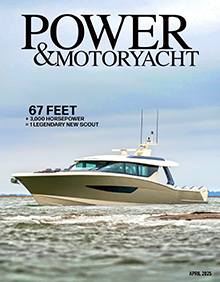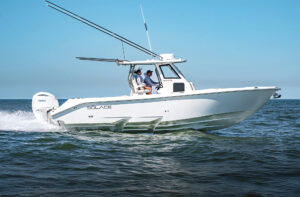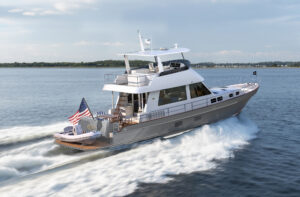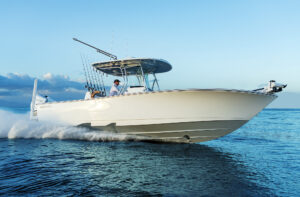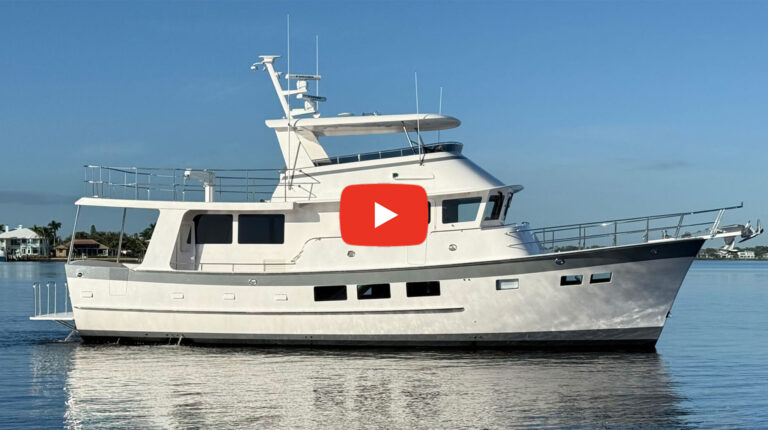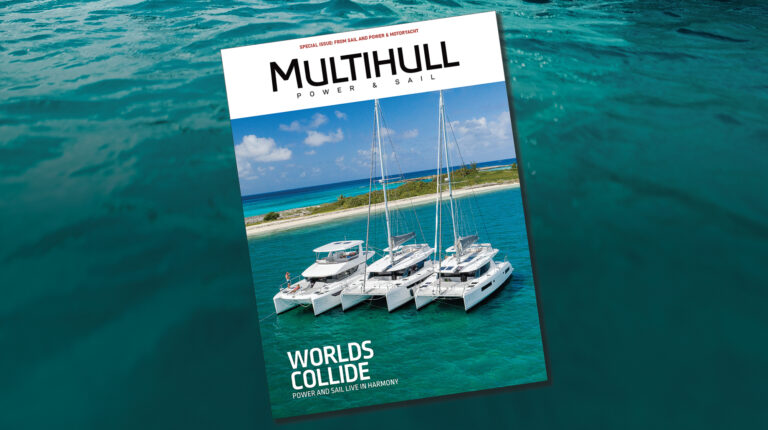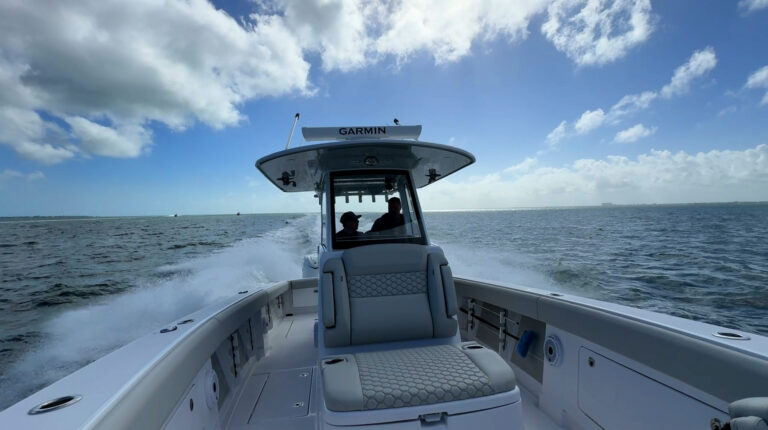
Sense of Duty
PT boats did more than just carry torpedoes and young men into battle during World War II. They’ve fired the imaginations of boaters young and old for decades. Jason Y. Wood paid a visit to the newly restored PT-305 in New Orleans to learn about what goes into making, and remaking, a PT boat, but
got a bit more than he bargained for.
When I stepped onto the deck of PT-305, I didn’t know where to look first. I was in the National World War II Museum’s brand-new, single-slip boathouse on the shores of Lake Pontchartrain in New Orleans. Twenty-odd people were milling around, including uniformed crew, staff and volunteers from the museum, and journalists. There was a lot to see. I took a glance over the starboard side to watch the smoke curling from a hullside exhaust port, then stepped forward to examine the wooden wheel at the helm, then pardon-me’ed my way through the gawkers aft to the 40-millimeter Bofors gun with its wire-frame bulls-eye sights positioned in front of its two crew seats.
On the way aft, of course, I had to take a quick peek down the hatch to see the three vintage Packard M2500 V-12 engines burbling away, while PT-305’s motor macs led by volunteer Jack Wade III, all wearing period-appropriate uniforms of dungarees with blue chambray shirts and sailor caps, plus modern-day hearing protection, were watchful as they went through precruise checks of cooling water flow, and exhaust and oil pressure.
PT-305 was looking good, with a lifeboat on her foredeck, jauntily tied fast over one-half of her charthouse. She was preparing to leave her cozy berth inside the corrugated steel boathouse. PT-305 fairly gleams, all fresh paint with nary a scuff on her gray deck. And she ought to, since she’s fresh out of the box from a 10-year refit and restoration undertaken by the National World War II Museum. With a dedicated staff mobilizing a seemingly irresistible force of volunteers, the museum has advanced its mission from celebrating the accomplishments of D-Day to helping visitors remember and understand the entire war effort.

It’s fitting enough, since the boats built by Higgins Industries here are the reason the museum is located in New Orleans. Indeed, the museum’s founder, the late historian Dr. Stephen E. Ambrose, author of the best-selling novel Band of Brothers, chose New Orleans specifically after President Eisenhower called Andrew Higgins “the man who won the war for us” because he developed the landing craft that made the D-Day invasions of Normandy possible.
Not to take away from the importance of those ungainly landing craft, but they failed to fire the imagination of a younger me quite like the PT Boats did.
As part of the PT-305 refit, the museum has added a full safety rail around the entire deck abaft the helm and some ingenious deck boxes with lids that fold open to reveal upholstered seating. While the overall look is somewhat diminished, there is enough authenticity—and plenty to take in—to override the issue. And the fact that those engines are running quickens my pulse: This is no dockside deck tour. This is the real thing. We are headed out on patrol on Lake Pontchartrain, the very waters where PT-305 initially splashed in May 1943.

For me, the idea of a PT Boat has always helped to feed into the mythology that began to form early on in my young mind of boating being more than merely a sport. Other contributors to this notion include the private boats that crossed the English Channel to rescue the British Expeditionary Force at Dunkirk, and the idea of Ernest Hemingway hunting submarines from the flying bridge of a sportfisherman in the Caribbean during World War II. Another spark came from the “Patrol Boat, River” featured in Apocalypse Now, an example of which my colleague, Executive Editor Bill Pike, set out to find in Southeast Asia just a few years ago.
For PT Boats of course, it was the idea of young yachtsmen, most notably Jack Kennedy, who stepped into military roles and brought their boathandling skills to the service of their country, that had always struck me as cool. Sure, the navy would add some training in communications and crew management and the ins and outs of the boat itself, but the real skill needed for the job lay in the operation and navigation of these speedy yachts. The word yacht, after all, is derived from the Dutch words jaghte or jaghtschip, meaning “hunting ship.”
For these PT Boats, the target was big game indeed, the supply ships and warships of the Japanese and German forces. And to take them on, PTs like the 305 carried four torpedoes, the sting of the mosquito fleet. Each torpedo was said to weigh a ton, with an explosive warhead of more than 500 pounds, and had contrarotating propellers spun by compressed air and a steam turbine. There the technology ended. In order to be effective, the torpedoes needed to be deployed at a range of a half-mile or less. Here’s why: To aim them, there was no guidance system. Instead, the skipper would simply line up the bow with where he wanted to place the torpedo based on the course and speed of his target, and then roll the activated torpedo over the side. Considering the short range, it’s no wonder the PT Boats rarely stuck around to see the outcome. The mosquito fleet would bug out—a true hit and run.
And there’s where the skill comes in, both of the American designers willing to push the limits, and those yachtsmen at the helms, who had to do the same to keep their crews safe.
PT-305 saw action in the Mediterranean theatre. She operated out of Livorno on the western coast of Tuscany as part of RON 22, a squadron of a dozen PT boats. During the summer months of 1944, PT-305 took part in the invasion of Elba, and also Operation Dragoon, the invasion of southern France. She was credited with sinking two German flak lighters, ferry barges used to transport troops or as gunboats in the area. In April of 1945 she returned to the U.S. to be overhauled and redeployed to the Pacific theatre, but the war ended and she was decommissioned in November. (To see what happened to her in the years following the war, see “The Making of a Time Machine” on page 51.)

Restoring a World War II combat-veteran PT Boat to be a museum exhibit on the hard, tucked safely behind the velvet ropes in a climate-controlled pavilion and meticulously cleaned each night—that’s one thing. But to refit a boat, to rebuild her from the keel up to float and run at speed (her best defense by design), and safely carry a crew and even passengers—that’s something else entirely.
“There are a set of standards from the Department of the Interior for the preservation of historic vessels, so we had a look at that and said ‘Okay this is what the professional standard is,’” says Tom Czekanski, senior curator and restoration manager at the National World War II Museum. “So, if you intend to operate this vessel and you have components that are becoming questionable, then you need to replace those components with like material.”
Because PT-305 was intended to be a living, breathing (supercharged, actually) exhibit from the get-go, with deck tours and boat rides to provide museum-goers with an immersive experience, Czekanski and his team paid close attention to that standard. “The overriding decision needs to be that the ship is sound and safe—not that I save a piece of wood that’s going to fall apart the first time I move the vessel,” he says. “So, it’s a nice standard to maintain the integrity of the vessel and you maintain the historical integrity as much as you can.”
This is not Czekanski’s first boat restoration. It’s not even his first Higgins. “We are very lucky here,” he says. “Before the museum opened, we were looking for Higgins landing craft. There were none available so we reconstructed one with some original parts and a lot of new parts and basically built one more landing craft. At that time we had people, who are still alive today, who had worked for Higgins. They were able to pass their knowledge onto people who were boatbuilders.” Then Czekanski and his team did another landing craft.

“PT-305 is the third Higgins vessel that this core group worked on,” Czekanski says. “Kind of like working for Ford or Chevy, where Ford does things one way and Chevy does things another way, Higgins did things a certain way. Between having the original craft, all the plans, and the experience of people who’d worked at Higgins, we were in very solid shape for this restoration.”
Acquiring three vintage Packard V-12 engines to rebuild was a tremendous find for the project’s authenticity. After all, to go to the effort of restoring the boat as accurately as possible only to have her powered by a set of three modern, quiet, clean-burning engines would shatter the illusion. The sounds, the smells, even the vibration—it’s all part of the experience.
“We’re still breaking in the engines and so we haven’t gotten over half throttle yet because we want to wear all those parts in,” Czekanski says. “So, at half throttle we were making 32 knots. She was originally supposed to make 43 knots fully combat-loaded with 15 crew—two officers and 13 enlisted men.” They might get there yet.
The weight of the boat is distributed somewhat differently now. “It goes back and forth,” Czekanski says. “We had to add some extra equipment, so we’ve got, for example, two auxiliary generators that the Coast Guard said we needed. But we’re not carrying four torpedoes that weighed a total of 8,000 pounds. The generators are heavy, but they’re not 8,000 pounds.”
She also carries 3,000 gallons of fuel, and the 100-octane aircraft gasoline she uses was going for about $6.50 per gallon at the time of this writing. “I don’t have a good handle on how much she’s sucking down now,” Czekanski says. “As an example, the fuel lines coming out of the fuel tanks are an inch and a half in diameter. On most cars it’s a quarter-inch or so. So, that gives an idea of the fuel flow.”

As PT-305 idled in reverse out into the sunshine under wispy high clouds, her lifejacketed complement of journalists all kept their seats around the deck as instructed by Capt. George Benedetto, until a signal was given that we could get up and move around.
When we were free to move, I made a beeline for the helm, peering into the machine gun station on the port side of the helm—basically a steel tub with a mail slot at about knee height where a much more spry—or less well fed than I—able seaman could clamber into position. A trim young woman with a large digital camera folded herself in there to snap a few frames. Benedetto goosed his throttles up, staying in touch with the engine-room crew through a radio headset. Only a bracket-mounted Raymarine gS Series multifunction display and the skipper’s wraparound shades and inflatable SOSpenders-style life vest infringed on the authenticity of the scene.
I shouted to Benedetto over the roar of the engines and wind that this must be a pretty cool gig.
“It’s really a dream come true,” he said with a wide grin. He put PT-305 into a few sweeping turns and kept her revved right up to speed. At around half throttle with those three Packard V-12s turning 1800 rpm and burning 100 gph (to the mellifluous tune of 96 decibels on deck) she did 27 knots.
At one point I looked around and to my eye the safety rails and the other journalists faded into the background as we slid across the coffee-with-milk surface of the lake. My ears hummed and I realized how exposed the young men of her crew must have felt standing on her deck. There’s really nowhere to hide. I scanned the sky for aircraft and imagined the terror of spotting an enemy plane pitching into a strafing dive—you’d have to see it, given that there’s no way in hell anyone on board could hear it coming.
I don’t know if this will make sense, but the effect cut both ways for me. On the one hand, a little of the romance around that yachtsman in service to his country was lost to me that day. But it was replaced with an understanding of something much more real. I could feel it thrumming up through the deck, through the soles of my shoes. The stakes were much higher than I had ever imagined.
See more photos of PT 305 here. ▶
Specifications
- Builder: Higgins Industries
- Model: Higgins PT Class
- Year: 1943
- LOA: 78’0″
- Draft: 5’3″
- Beam: 20’6″
- Displacement: 110,000 lb.
- Fuel Capacity: 3,000 gal.
- Standard Power: 3/1,500-hp Packard M2500 V-12 engine
This article originally appeared in the August 2017 issue of Power & Motoryacht magazine.

